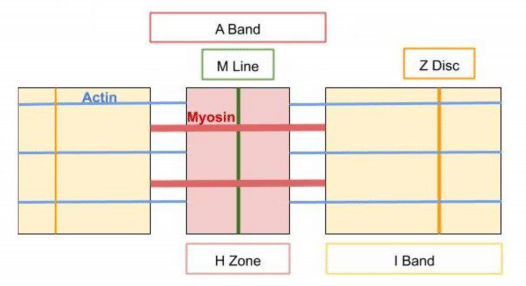
A big part of scoring well on the Biological and Biochemical Foundations of Living Systems section is familiarizing yourself with muscular system MCAT content. Below, we’ll go over some key facts about skeletal muscles, smooth muscle contraction, and more.
For a super handy PDF version of this material, and for more MCAT resources, click the link below!
Organization of Skeletal Muscles
First and foremost, here’s a simple breakdown of how skeletal muscle is organized:

You’ll also need to understand the difference between smooth muscle and skeletal muscle, which we’ve broken down for you here:
| Function | Contraction | Appearance | |
|---|---|---|---|
| Smooth Muscle | Surround organs (except for the heart) and blood vessels | Involuntary | Nonstriated or tapered |
| Skeletal Muscle | Moves the skeleton | Voluntary | Striated, multinucleated |
Sarcomere MCAT Structure and the Sliding Filament Model
Understanding how muscles actually work is also key to success on the MCAT. Muscle contraction occurs when the motor protein, myosin, pulls on actin. The filaments move past one another, shortening the sarcomere and generating muscle tension.
For reference, sarcomere is the smallest functional unit of muscle, visible as striations on muscle cells.
The sliding filament model, as seen below, is used to represent this function in the muscular system. MCAT questions may pertain to any of the follow aspects of muscle contraction:

Muscle Components
To better understand the above model, it helps to know the various components of muscle and how they help facilitate contraction:
| Component | Definition | Effect on Contraction |
|---|---|---|
| Thick filament | Composed of myosin | Myosin heads bind to actin |
| Thin filament | Composed of actin | Slides past myosin |
| Z-Line | Mark the borders of the sarcomere. Site of connection for actin. | Moves closer together |
| M-line | Midline of the sarcomere | No change |
| I Band | Contains only thin filaments | Shortens |
| H Band | Contains only thick filaments | Shortens |
| A Band | The length of the thick filaments | No change |
And when trying to memorize the functions of each of the above muscle components, here is one of our favorite memorization tips:
- “The letter H is thicker than I”
H Band = Thick filament
I Band = Thin filament“HI is short for Hello”
H and band I shorten in contraction
A Final Word on Muscular System MCAT Questions
Scoring well on the Biological and Biochemical Foundations of Living Systems section of the MCAT requires knowledge about the muscular system. Specifically, you’ll want a deep understanding of the interrelated parts and how they come together to create contraction and movement.
For more MCAT practice, check out Magoosh’s MCAT prep, which includes 380 lessons, 745+ practice questions, personalized email assistance, and more!
Happy studying and good luck!







